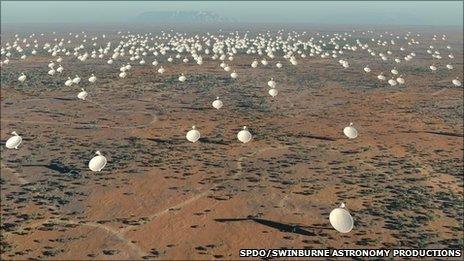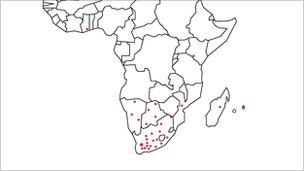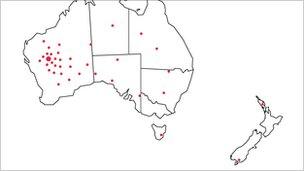World's biggest radio telescope, Square Kilometre Array
- Published

An artist's impression of telescope dishes at the heart of the network
Scientists from 20 countries are working on plans to create a vast network of radio telescopes, the size of a continent that could reveal the birth of planets and galaxies, the mysteries of dark energy as well as joining the search for signals from alien civilisations.
The Square Kilometre Array (SKA) takes its name from the size of its collecting area. But instead of a single radio dish 1km across, it will be made up of thousands of smaller ones.
"The dishes are going to be elliptical, about 15m (49ft) across," says Richard Schilizzi, Director of the International SKA project, "and very simple because they have to be cheap, especially if you want 3,000 of them." And that is indeed the number they are talking about.
The vast array is needed because the wavelength of radio waves is far greater than that of visible light.
An optical telescope can be 10 million wavelengths in diameter. Scale that up to the centimetre wavelengths of radio astronomy and you have a problem, says Simon Garrington, Director of the e-Merlin array at the Jodrell Bank Radio Observatory near Manchester.
"In order to get the same level of detail as a good optical telescope you'd need something 100km across. Clearly you can't build a single telescope a 100km across, but what you can do is build a network of telescopes and link those telescopes together," he adds.
The SKA should offer 50 times greater sensitivity and 100 times better resolution than any radio telescope array on Earth so far.
So far, partners from 20 countries are involved in the 1.5bn euros (£1.3bn) project which is not expected to be completed until about 2024, though phase one should be working by the end of this decade.
Competition to host the array is intense and has been narrowed down to two strong proposals, one for it to be centred in Western Australia, the other in the Northern Cape of South Africa.
"One of the most important things is to find a site that has very little interference from radio transmissions. If there's anything broadcasting a strong signal nearby it will blind the telescope, a bit like trying to see the stars when the Sun is up," explains director of the South Africa project, Bernie Fanaroff.
"You don't want mobile phone coverage, you don't want a lot of people around, you don't want cars around.
"In fact, when we were doing our initial tests we even found that a chap running the tests was causing interference by sitting down in a plastic chair," he adds.

A South African SKA would stretch to Ghana and Kenya ...
In the completed array about 50% of the dishes will be in the central 5km, a further 25% out to 200km. But the final 25% will stretch out to more than 3,000km.
South Africa's bid would include dishes in Namibia, Botswana, Mozambique, Madagascar, Zambia, Mauritius, Kenya and Ghana.
From Australia, they will reach as far as New Zealand.

... while a Western Australian SKA would reach New Zealand
"Australia's proposed core site, the Murchison Radio Observatory, is located in one of the most sparsely populated regions of the planet," says bid director, Brian Boyle.
"Moreover, Australia and New Zealand together provide the flexibility to place array stations across 5,500km."
The array will contain conventional curved dishes which can be pointed at an area of space and bring the radio waves to a focus.
But other parts of the network will be flat plates which detect waves within the plates themselves. These will work as a phased array which can be directed instantly without moving thanks to sophisticated electronics which account for the time lag as the same radio signal reaches different parts of the network.
Chris Shenton, UK Project Manager of the preparatory phase of the SKA at Jodrell Bank says that this also allows the telescope to look in different directions at once.
"We can in fact deploy as many [detection] beams as we want, and the advantage of that is we could do multiple experiments simultaneously.
"For example, we could be doing a survey with one beam and very detailed observations with another."
Linking the network together will be no easy problem to solve.
The signals must be timed to a billionth of a second and it will take enough fibre optic cable to go twice around the Earth to link them. And then each pair of dishes has to be compared by computer.
Each telescope produces about 20GB of data every second - enough to fill a computer hard disk in minutes. "It will take a huge computing power," says Richard Schilizzi. "Our estimate is that it will need the biggest supercomputer on the planet."
There are several big science questions the array should answer, including how planets form, how gravitational waves stretch the fabric of the universe and how the first galaxies evolved.
Steve Rawlings of Oxford University hopes it might explain mysterious dark energy:
"The Square Kilometre Array is a time machine. As you look out to greater distances you're seeing the universe as it was when it was younger, and so you can map out the expansion of the universe."
Dark energy seems to accelerate that expansion and so we will be able to map out dark energy and perhaps discover what it is."
SKA project scientist Joseph Lazio at NASA's Jet Propulsion Laboratory in California is hoping for an even more exciting discovery - radio signals from extraterrestrials.
"Only with enough sensitivity, enough metal on the ground, as the SKA will provide, do you get to the point where you can hope to detect an earth-like planet around some of the nearest stars on the basis of artificial radio transmission.
"Perhaps in 50 years we will be able to say yes, there is another technological civilisation fairly close to us."
In the meantime, the international steering committee for the SKA is meeting this week to decide where their headquarters office will be.
The choice is between Holland, Germany and Jodrell Bank in the UK. Next year they hope to decide where the array itself will be built.
Brian Boyle is sure it will make major discoveries, expected and unexpected. "The SKA. will be a truly transformational scientific instrument. We will discover things that we have not even thought of."
BBC Radio 4's The Biggest Radio on Earth is broadcast on Thursday, 31 March 2011 at 2100 BST. Or catch up afterwards via iPlayer
- Published2 April 2011